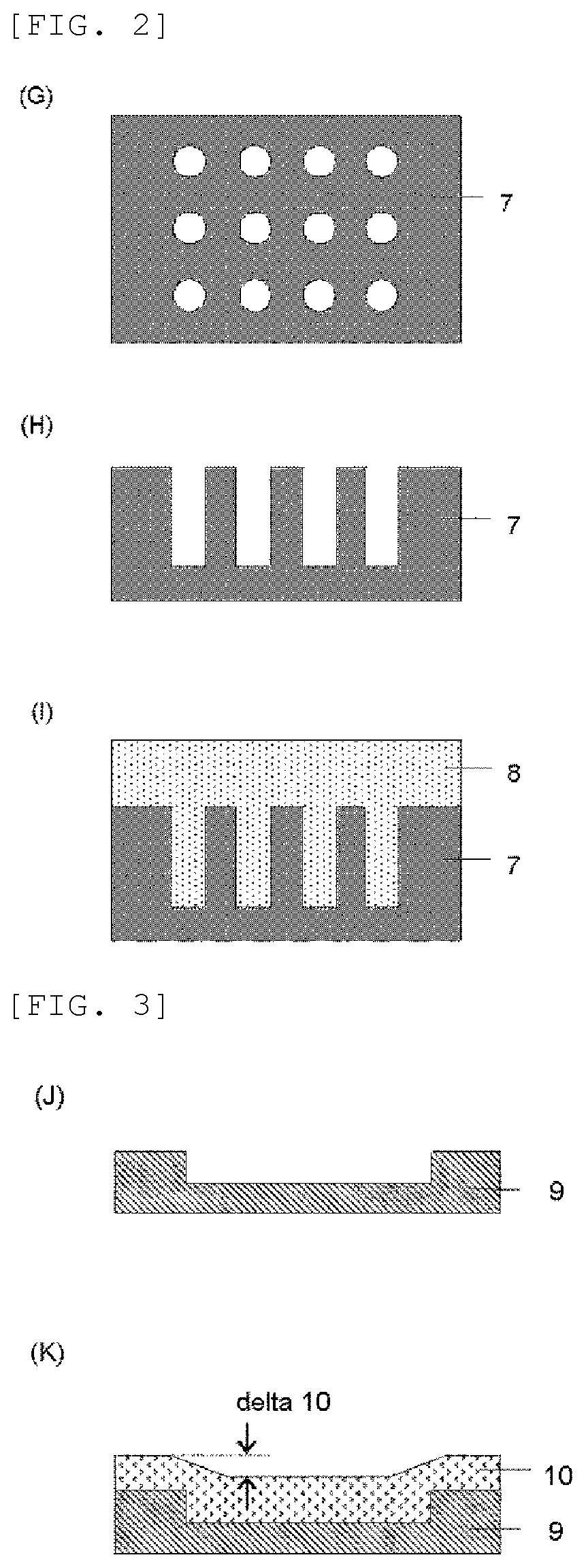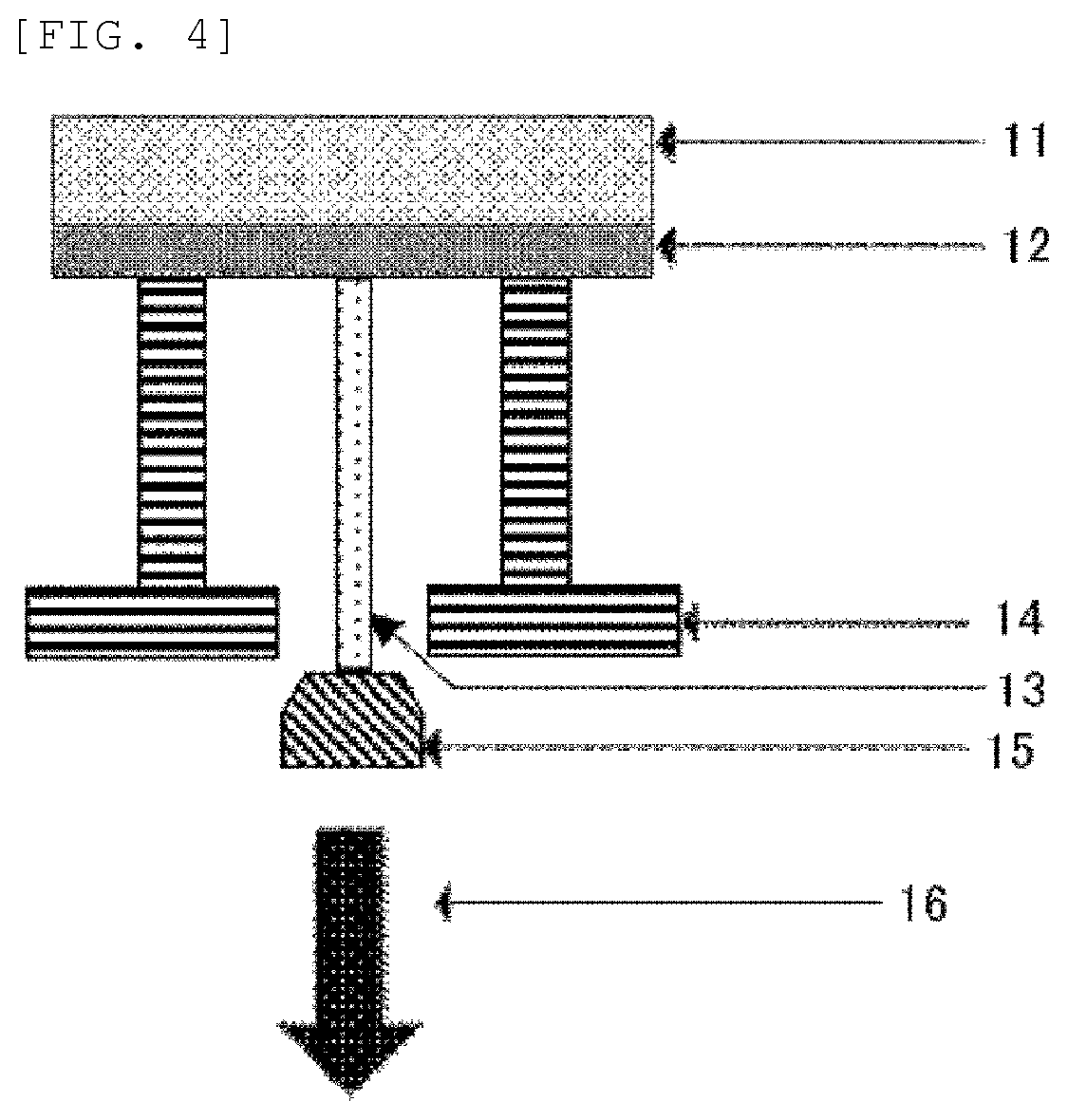Material for forming organic film, method for forming organic film, patterning process, and compound
a technology of organic film and patterning process, which is applied in the field of organic film material, organic film method, patterning process, compound, etc., can solve the problem of not having a dry etching method capable of providing absolute etching selectivity, the aspect ratio of the material becomes so large, and the pattern collapse occurs consequently. , to achieve the effect of excellent adhesive force to the substrate, high filling property, and high planarizing property
- Summary
- Abstract
- Description
- Claims
- Application Information
AI Technical Summary
Benefits of technology
Problems solved by technology
Method used
Image
Examples
synthesis example 1
[Synthesis Example 1] Synthesis of Compound (A1)
[0300]
[0301]Under a nitrogen atmosphere, a homogeneous solution with an inner temperature of 100° C. was prepared from 20.0 g of Epoxy Compound (B1), 19.9 g of Phthalimide Compound (C1), and 200 g of 2-methoxy-1-propanol. Then, 1.00 g of benzyltriethylammonium chloride was added thereto and stirred for 12 hours with the inner temperature of 120° C. After cooling to room temperature, 300 ml of methyl isobutyl ketone was added, and washing was performed twice with 100 g of a 2% NaHCO3 aqueous solution and 100 g of a 3% nitric acid aqueous solution, and five times with 100 g of ultrapure water. The organic layer was evaporated under reduced pressure to dryness. Thus, Compound (A1) was obtained. The weight-average molecular weight (Mw) and dispersity (Mw / Mn) thereof was determined by GPC. The results were Mw=780 and Mw / Mn=1.02.
[Synthesis Examples 2 to 29] Synthesis of Compounds (A2) to (A29)
[0302]Compounds (A2) to (A29) as shown in Tables ...
example 1
ess and Filling Property Evaluations (Examples 1-1 to 1-32, Comparative Examples 1-1 to 1-4)
[0310]As shown in FIG. 2, the materials (UDL-1 to -32, Comparative Example UDL-1 to -4) for forming an organic film were each applied onto a SiO2 wafer substrate having a dense hole pattern (hole diameter: 0.16 μm, hole depth: 2.0 μm, distance between the centers of adjacent two holes: 0.32 μm), the SiO2 wafer substrate having been treated with hexamethyldisilazane (HMDS). The resultant was baked with a hot plate in the atmosphere under conditions shown in Tables 4-1 and 4-2. Thereby, an organic film 8 was formed. The substrate used was a base substrate 7 (SiO2 wafer substrate) having a dense hole pattern as shown in FIG. 2 (G) (top view) and (H) (sectional view). The sectional shapes of the resulting wafer substrates were observed with a scanning electron microscope (SEM) to check whether or not the holes were filled with the organic film without voids (space). Tables 4-1 and 4-2 show the re...
example 2
ng Property Evaluation (Examples 2-1 to 2-32, Comparative Examples 2-1 to 2-4)
[0312]The materials (UDL-1 to -32, Comparative Example UDL-1 to -4) for forming an organic film were each applied onto a base substrate 9 (SiO2 wafer substrate) having a giant isolated trench pattern (FIG. 3 (J), trench width: 10 μm, trench depth: 0.10 μm), and baked with a hot plate in the atmosphere under conditions shown in Tables 5-1 and 5-2. Then, a step (delta 10 in FIG. 3 (K)) between the trench portion and the non-trench portion of an organic film 10 was observed with an atomic force microscope (AFM) NX10 manufactured by Park systems Corp. Tables 5-1 and 5-2 show the results. In this evaluation, the smaller the step, the better the planarizing property. Note that, in this evaluation, a trench pattern having a depth of 0.10 μm was generally planarized using an organic film material having a film thickness of 200 nm. This is a severe evaluation condition to evaluate the planarizing property.
TABLE 5-1...
PUM
| Property | Measurement | Unit |
|---|---|---|
| boiling point | aaaaa | aaaaa |
| temperature | aaaaa | aaaaa |
| temperature | aaaaa | aaaaa |
Abstract
Description
Claims
Application Information
 Login to View More
Login to View More - R&D
- Intellectual Property
- Life Sciences
- Materials
- Tech Scout
- Unparalleled Data Quality
- Higher Quality Content
- 60% Fewer Hallucinations
Browse by: Latest US Patents, China's latest patents, Technical Efficacy Thesaurus, Application Domain, Technology Topic, Popular Technical Reports.
© 2025 PatSnap. All rights reserved.Legal|Privacy policy|Modern Slavery Act Transparency Statement|Sitemap|About US| Contact US: help@patsnap.com



